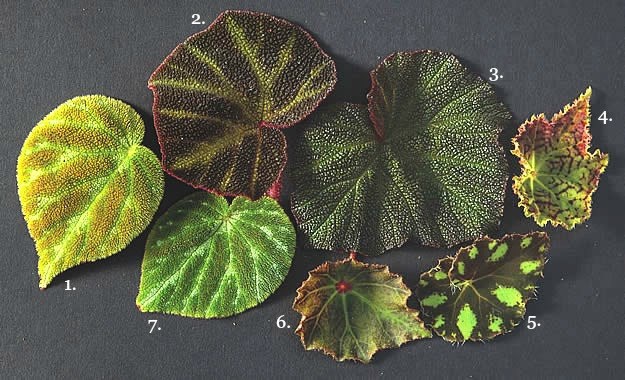
Typically employed as houseplants and in shaded summer beds, Begoniaceae have tropical and subtropical origins and are known for their asymmetrical leaf shapes. But this is where the commonalities among different species end. There are eight main classes of begonias, encompassing all manner of size, color, and shape of flower and leaf. Leaves can be glabrous (smooth) or pubescent (hairy) and grow in the shape of spirals, dinner plates, and dragons’ wings.
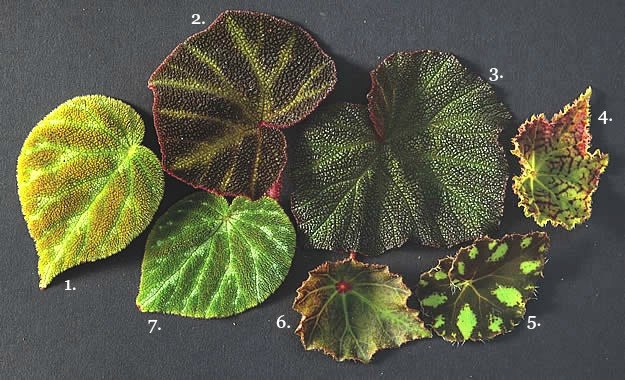
1. ) Begonia ‘Brown Jewel’
2. ) B. soli-mutata
3. ) B. ‘Art Hodes’
4. ) B. ‘Deco Checks’
5. ) B. ‘Tiger Eye’
6. ) B. ‘Boyfriend’
7. ) B. ‘Green Jewel’.
(Photo by: Ingalls Photography)
The largest class is Rhizomatous, with more than 700 species, mostly hailing from Mexico, South America, and Central America. They are distinguished by their relatively thick stems, or rhizomes, that grow horizontally near the soil surface and sprout new roots and leaves. The rhizome begonia have some of the most interesting leaves and stems and provide an enormous gene pool for breeding. Superstars such as Begonia ‘Escargot,’ B. ‘Iron Cross,’ and B. ‘Benitochiba’ have their roots firmly planted in this class.
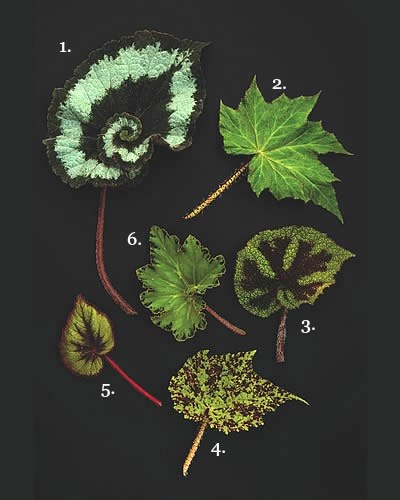
1. ) B. Escargot
2. ) B. ricinifolia
3. ) B. ‘Iron Cross’
4. ) B. ‘Marmaduke’
5. ) B. ‘Fire Flush’
6. ) B. ‘Erythrophylla’.
(Photo by: Ingalls Photography)
Cane-like begonias are one of the most popular classes and are especially suitable for houseplant culture. They usually have an upright growth habit with segmented stems that resemble bamboo. They have beautiful foliage and bloom in a wide array of colors, typically in spring and summer, though some bloom all year round. They also make spectacular components in outdoor container plantings: a mature clump of B. ‘Cracklin’ Rosie’ or B. maculata var. ‘Wightii’ sporting their spotted, angel-wing leaves; long, elegant legs; and trusses of pink or white blooms are difficult to beat.
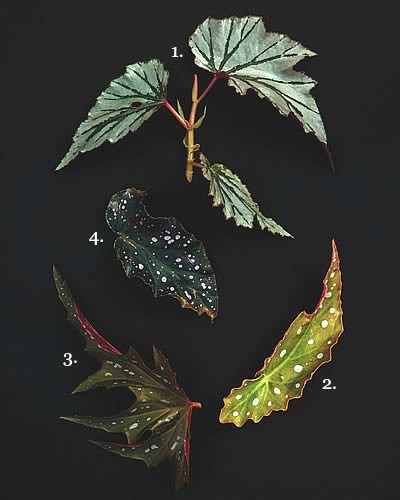
1. ) B. ‘Looking Glass’
2. ) B. ‘Wightii’
3. ) B. ‘Sophia’
4. ) B. ‘Cracklin’ Rosie’.
(Photo by: Ingalls Photography)
In addition, there are the thick-stemmed, shrub-type, wax/Semperflorens, and trailing-scandent classes, which all have countless variations of leaf, form, and flower. The two remaining classes—Rex Cultorum and Tuberous—are probably the most popular and available of all, sold year-round by florists and garden centers. (The Rex Cultorum class is actually a type of rhizomatous begonia but is classified based on its distinctive foliage.) Much loved for their showgirl-like foliage and dainty blooms, the Rex begonia are always in demand. Somewhat challenging to grow as houseplants but ideally longer-lasting than a bouquet of cut flowers, a Rex brightens up just about any windowsill—for a time. If it’s not happy, it will let you know by dropping all its leaves and spiraling into a sulky dormancy that may prove permanent. For outdoor summer use in bedding and containers, however, Rex begonia make wonderful candidates, especially when combined with ferns and other semi-shade lovers.
If the Rex is the showgirl of the begonia world, then Tuberous begonia are the supermodels. Starting off as dull, odd-shaped, plum-size brown tubers, within a few weeks of their resurrection they attain runway-worthy status by showing of huge, eye-catching camellia-like blooms.
Most begonia can be propagated from seed or from leaf or leaf-chip cuttings that are pressed into a clean growing medium, but they also have an interesting sex life of their own. Being monoecious (they have separate male and female flowers on the same plant), they are able to breed with themselves or with others. Possibly to assure diversification, though, the male flowers usually bloom before the female. Crossbreeding within such a large genus has allowed for countless combinations of exotic plants with questionable parentage.
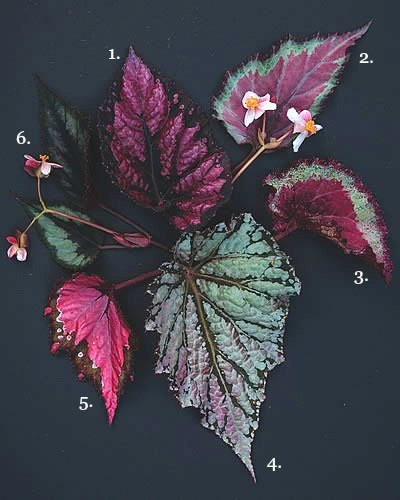
1. ) B. ‘Chicago Fire’
2. ) B. ‘Spitfire’
3. ) B. ‘Libra’
4. ) B. ‘Fairy’
5. ) B. ‘Houston Fiesta’
6. ) B. ‘Maui Mist’.
(Photo by: Ingalls Photography)
Tovah Martin, author of The Unexpected Houseplant (Timber Press, 2012), once was steward to hundreds of different species and cultivars while working at Logee’s Greenhouses in Danielson, Connecticut. Martin had her own way of breeding begonia: when one of her plants had a copious amount of female flowers that were “in the mood,” she took the plant to a fellow begonia enthusiast’s house and let their charges take it from there. Rhizomatous begonias are her favorites; she’s even credited with developing named cultivars (a popular one is Othello).
When Martin moved to an old farmhouse that was drafty and cool during the winter months, she thought her begonia-growing days were over. Instead, she’s been able to maintain a sizable collection by keeping them indoors and on the dry side during the winter and moving them to a shaded outdoor location for the duration of the summer. Most classes do well for Martin, with the exception of the Rex begonia, which are infamous for being short-lived, fussy about water (yes to high humidity but no to wet feet), and susceptible to powdery mildew and botrytis. When asked for her thoughts about Rexes, she says they’re a wonderful plant—to regift.
How to Grow Begonias
Light: East-, west-, or south-facing windows are best. If any burning occurs when grown in a south-facing window, move the plant farther from the window. As an alternative, begonia do well under grow lights.
Water: Probably the quickest way to kill a begonia is too much water. Let them dry out between waterings. If they are kept cool, you may notice they can tolerate a longer time without water. Be sure not to let them sit in a saucer full of water.
Humidity: Begonia thrive on water in the form of humidity. Pebble trays or a daily misting works wonders. Growing begonia near a window in a bathroom with a frequently used shower is a perfect solution.
Soil and Potting: A well-draining commercial soilless mix is ideal, though Tovah Martin prefers a good soil. Begonia much prefer to be pot-bound rather than given too much room. Martin points out that with these plants, the more the merrier, since a group will raise the humidity for the collective. Only repot when necessary, and, preferably, in spring before plants are moved outside and start actively growing.